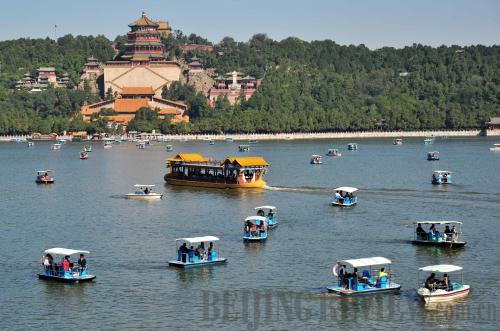|
 |
|
BOAT TOUR: Ferry boats fill Kunming Lake at the Summer Palace during the National Day holiday (XINHUA) |
I am alone in the Summer Palace in northwest Beijing, the largest and best-preserved imperial garden in China.
Three Chinese tour groups are admiring the bronze qilin statue, which has the face of a lion, horns and split hooves of a deer, and was believed to have a magical power to protect the emperor in the past. The sign says the Summer Palace was first built in 1750, the 15th year of Emperor Qianlong's reign in the Qing Dynasty (1644-1911).
As I meander on zigzagging walkways, I recall the old saying that "evil spirits can only fly in a straight line," and so bad spirits are unable to sail into the inner gardens of the palace and Kunming Lake. Kunming Lake gives me solace, as wavelets lap lazily. When workers dug out this lake, they built a hill named Longevity Hill. Willow trees sway nearby. Lotus leaves tilt, as they age, in green and autumn shades.
A number of Chinese extended families pass me, and I feel a bit homesick. I remember flashes of Chinese paintings showing young children "learning from their elders."
Back in 1986, I walked around the lake on the Long Corridor, chatting as I went. Now, I take a deep breath to study the curved, white bridges for a Chinese brush painting I will do when I get home. The Summer Palace looms to my right; its sloping golden tile roofs are horizontal, while the red and green pagoda is vertical. Thus, harmony is restored.
I promised my husband that I would not go anywhere alone. Yet here I am.
Today, I am not a tourist. A sense of liberation washes over me.
"How are you? The view is astounding!" I say to three college students in Chinese. I learned it in university.
"Yes!" they say.
The Summer Palace in Chinese is called Yi He Yuan, or Garden of Nurtured Harmony. Tour boats are moored down the way, but only one or two have been hired to take passengers.
Suddenly, I hear five Beijingers sing a hearty Chinese song. They are next to a hexagonal pavilion, while other folks nearby munch on watermelon. I turn to listen. The singers laugh at the end with the intimacy of friends who come here often. They are middle aged and stylishly dressed. Last time I was here, I saw only grey-green Mao jackets.
Sitting still on a massive boulder, I grab my red pocket notebook to write a poem.
Miniature Chinese paintings on wood decorate the facade above me. They cover the interior and exterior of the eaves just like the ones on the Long Corridor. Here is how the Empress Dowager Cixi (1835-1908) was entertained as she walked. These miniature paintings are like a Chinese early version of a movie: The walker traverses past while the pictures change. Last time I walked too fast. This time, I'll linger. Here are sparrows in a pine tree; there's the kingfisher. Now I nearly smell a fragrant osthmanthus; scholars are near a rock drinking wine; a waterfall cascades in a landscape. Each is hand-painted with elegance and simplicity: the Confucian scholarly ideal.
I stroll to a food stand. Sitting comfortably on the cement wall, I munch on plain popcorn and sip ice water while observing several different grandmothers with their single charges. These grannies are forced to chase their wee ones away from the lakeshore wall. A girl dressed in a black and white cocktail dress poses provocatively for her boyfriend.
I enter a side museum which is tucked out of sight. Cases feature Shang and Han dynasty bronze urns, from roughly 1,600 B.C. to A.D. 220. I see officials' swords made of Chinese steel, imperial jewelry of jade and painted scrolls mounted on silk.
Moving in closely, I try to read the brush strokes on a bamboo-in-front-of-the-moon painting. I can only read a few words. The modulated lines of calligraphy on each scroll are masterful. A scholar next to me is reading in a whisper.
As I find my way outside of the Summer Palace, I walk a half mile to catch a taxi since Beijingers are quickly snatching the closest cabs. My taxi pulls over. I ask the driver to take me to Peking University West Gate in Chinese.
"Don't go alone in a taxi if you can avoid it," my husband said before I left home. I feel quite safe here.
"Why do you speak Chinese?" asks the cabbie. I explain about the East West Center scholarships at the University of Hawaii. The kind driver tells me he is married and has two children. We arrive at my destination soon.
I have a story to tell my grandchildren. I know how Beijingers relax.
The author is an American who has visited China
Email us at: zanjifang@bjreview.com | 